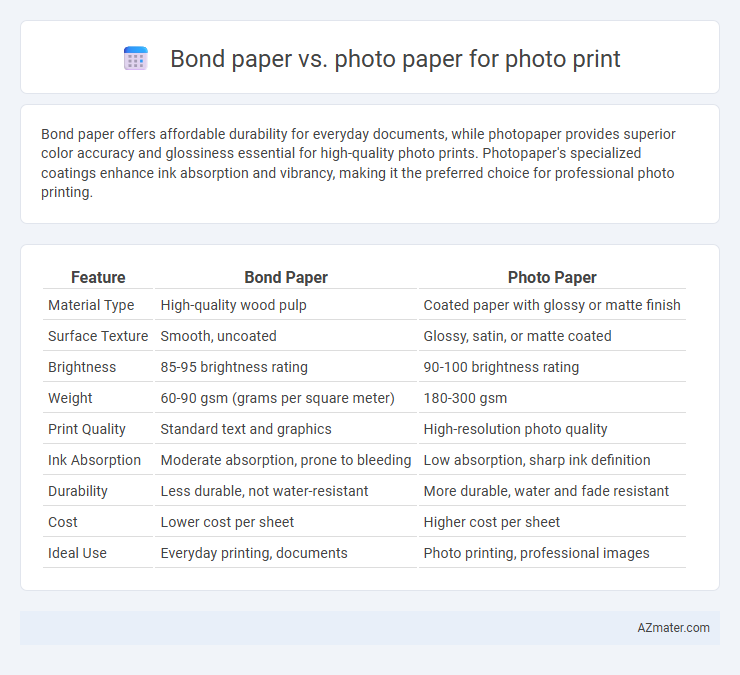Bond paper offers affordable durability for everyday documents, while photopaper provides superior color accuracy and glossiness essential for high-quality photo prints. Photopaper's specialized coatings enhance ink absorption and vibrancy, making it the preferred choice for professional photo printing.
Table of Comparison
| Feature | Bond Paper | Photo Paper |
|---|---|---|
| Material Type | High-quality wood pulp | Coated paper with glossy or matte finish |
| Surface Texture | Smooth, uncoated | Glossy, satin, or matte coated |
| Brightness | 85-95 brightness rating | 90-100 brightness rating |
| Weight | 60-90 gsm (grams per square meter) | 180-300 gsm |
| Print Quality | Standard text and graphics | High-resolution photo quality |
| Ink Absorption | Moderate absorption, prone to bleeding | Low absorption, sharp ink definition |
| Durability | Less durable, not water-resistant | More durable, water and fade resistant |
| Cost | Lower cost per sheet | Higher cost per sheet |
| Ideal Use | Everyday printing, documents | Photo printing, professional images |
Introduction to Photo Printing Substrates
Photo printing substrates significantly influence image quality, durability, and color accuracy. Bond paper, known for its affordability and smooth surface, suits everyday printing but lacks the vibrant color reproduction and water resistance found in photopaper. Photopaper features a specially coated surface designed to enhance ink absorption, producing sharper details, richer colors, and longer-lasting prints ideal for professional photography and high-quality photo prints.
What Is Bond Paper?
Bond paper is a durable, high-quality writing or printing paper typically used for documents and letterheads rather than photo printing. It has a smooth surface but lacks the glossy or coated finish essential for vibrant photo reproduction found in photopaper. Photopaper is specially designed with a light-sensitive coating that enhances color density, sharpness, and durability in photo prints, making it the preferred choice for high-resolution, vivid images.
What Is Photo Paper?
Photo paper is a specially coated paper designed to enhance ink absorption and color vibrancy, making it ideal for high-quality photo prints. Unlike bond paper, which is typically used for everyday printing and lacks the glossy or matte finishes of photo paper, photo paper provides sharp details and rich color saturation. This makes photo paper essential for preserving the visual integrity of photographs and professional images.
Surface Texture and Finish Comparison
Bond paper features a smooth, matte surface texture that absorbs ink moderately, resulting in less vibrant photo prints compared to photopaper. Photopaper typically offers glossy or satin finishes with a highly engineered coating that enhances color saturation and sharpness, making images appear more vivid and detailed. The choice between bond paper and photopaper significantly impacts print quality, with photopaper providing superior surface texture and finish optimized for high-resolution photo printing.
Image Quality: Color Vibrancy and Sharpness
Photopaper delivers superior color vibrancy and sharpness due to its coated surface that enhances ink absorption and prevents bleeding, resulting in vivid, crisp images. Bond paper lacks this specialized coating, causing colors to appear duller and edges less defined, which diminishes overall photo quality. Choosing photopaper ensures high-resolution prints with rich, accurate color reproduction ideal for professional photo printing.
Durability and Longevity of Prints
Bond paper offers moderate durability with a smooth texture suitable for everyday photo prints, but it is susceptible to fading and damage over time due to its lower weight and less specialized coating. Photopaper, especially those with glossy or luster finishes, provides superior longevity and resistance to fading, moisture, and UV exposure, making it ideal for archival-quality photo prints. Choosing photopaper enhances the durability and preservation of prints, ensuring vibrant colors and sharp details remain intact for years.
Cost Differences: Bond Paper vs Photopaper
Bond paper generally costs significantly less than photopaper, making it a budget-friendly option for everyday printing needs, while photopaper is specifically designed for high-quality photo prints with a higher price point due to its specialized surface and ink absorption capabilities. The price gap between bond paper and photopaper can vary depending on brand, weight, and finish, but photopaper often costs two to three times more per sheet than standard bond paper. Choosing photopaper enhances print durability and color vibrancy at a premium cost, whereas bond paper suits cost-sensitive projects with less demanding image quality requirements.
Ink Absorption and Drying Time
Bond paper has moderate ink absorption, which can cause slower drying times and potential ink bleeding when used for photo printing. Photopaper features specialized coatings that enhance ink absorption, enabling faster drying and sharper image quality. Choosing photopaper ensures vivid colors and reduced smudging due to its optimized surface for inkjet or dye-based inks.
Best Use Cases for Each Paper Type
Bond paper excels in professional documents, flyers, and presentations requiring durability and crisp text, but lacks the vibrant color reproduction ideal for photo prints. Photopaper is designed specifically for high-resolution, vivid photo printing, offering glossy, matte, or satin finishes that enhance color depth and detail for photographs and art prints. Choosing photopaper is best for personal or commercial photo projects where color accuracy and image quality are paramount, whereas bond paper suits everyday printing tasks demanding reliability and crispness.
Final Recommendations: Choosing the Right Paper
Photopaper delivers superior photo print quality with vibrant colors and sharp details, making it ideal for professional or display purposes. Bond paper lacks the glossy finish and color accuracy needed for high-resolution photo prints but remains cost-effective for draft or casual prints. For the best photo print results, select photopaper tailored to your printer type and ink compatibility to ensure longevity and color fidelity.

Infographic: Bond paper vs Photopaper for Photo print
 azmater.com
azmater.com